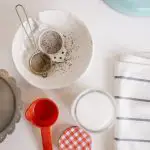Are you looking to add a touch of elegance to your next cake creation? Learn how to put fabric lace on a cake and take your baking skills to the next level.
In this guide, we will show you the steps to choosing the right lace fabric, preparing it for the cake, and applying it seamlessly. With our tips and tricks, you’ll be able to create a stunning lace design that will impress your guests.
Let’s get started!
Table of Contents
Choosing the Right Lace Fabric
When choosing the right lace fabric, it’s important to consider the design and durability.
There are various types of lace fabrics available, each with its own unique design and characteristics. Some popular lace fabric types include Chantilly lace, guipure lace, and Alençon lace.
Chantilly lace is delicate and features intricate floral patterns, making it perfect for elegant and feminine designs. Guipure lace, on the other hand, is heavier and has a more structured appearance, making it ideal for creating bold and statement-making pieces. Alençon lace is known for its exquisite detailing and is often used in bridal wear.
In addition to considering the design, it’s also crucial to think about the durability of the lace fabric. Lace fabrics can be delicate, so proper care is essential to maintain their beauty and longevity.
To care for lace fabric, always follow the care instructions provided by the manufacturer. Most lace fabrics require gentle hand washing or dry cleaning to prevent damage. Avoid using harsh detergents or bleach, as these can weaken the fibers and cause them to fray. It’s also important to store lace fabrics properly, away from direct sunlight and in a cool, dry place, to prevent discoloration or deterioration.
Preparing the Lace Fabric for the Cake
Before attaching the lace to your cake, it’s important to properly prepare the fabric. Handling delicate lace requires some extra care and attention to ensure the best results.
Start by gently washing the lace fabric in cold water with a mild detergent. Avoid any harsh rubbing or twisting, as this can damage the delicate fibers. After washing, carefully rinse the lace to remove any soap residue.
Next, lay the lace flat on a clean towel and gently pat it dry. Avoid wringing or squeezing the lace, as this can distort its shape. Once the lace is dry, it’s a good idea to press it with a low heat iron to remove any wrinkles. Place a thin cloth or ironing sheet over the lace to protect it from direct heat. Move the iron in a gentle, sweeping motion to avoid snagging or pulling the lace.
Once the lace is properly prepared, you are ready to attach it to your cake and create a beautiful, elegant design.
Applying the Lace Fabric to the Cake
To attach the lace, gently brush a thin layer of edible adhesive onto the surface of the cake. Make sure the adhesive is evenly spread to ensure the lace adheres properly.
Once the adhesive is applied, carefully place the lace fabric onto the cake, smoothing it out gently to remove any wrinkles or bubbles. If you encounter any issues while applying the lace, here are some troubleshooting tips to help you out.
Firstly, if the lace fabric tears or rips while you are trying to apply it, don’t panic. Simply cut a small piece of lace to patch the tear, and use a little more adhesive to secure it in place. This will help to hide any imperfections and ensure that the lace stays intact.
If you find that the lace is not sticking to the cake as well as you would like, try using a small brush to apply a little more adhesive underneath the edges of the lace. This will help to secure it more firmly and prevent it from peeling off.
Now, let’s talk about some creative lace design ideas. You can experiment with different lace patterns and designs to create a unique look for your cake. Consider using different colors of lace to add a pop of color or layering different lace fabrics to create a textured effect.
Securing the Lace Fabric in Place
Securing the lace is essential to ensure it stays in place and doesn’t come off. Here are some tips for securing lace fabric on a cake:
-
Use edible adhesive: Edible glue or royal icing can be used to secure the lace fabric onto the cake. Apply a thin layer of adhesive to the back of the lace and gently press it onto the cake. Make sure to smooth out any wrinkles or air bubbles.
-
Use pins or toothpicks: If you want a more temporary solution, you can use pins or toothpicks to hold the lace in place. Simply insert them into the cake at strategic points along the edges of the lace. Be careful not to use too many or place them in areas where they will be visible.
-
Use fondant or buttercream: Another creative way to secure lace fabric is to incorporate it into your cake design using fondant or buttercream. Roll out a thin layer of fondant or pipe a delicate lace pattern with buttercream onto the cake. Then, gently press the lace fabric onto the fondant or buttercream. This will not only secure the lace but also create a beautiful textured effect.
Adding Decorative Elements to the Lace Design
In this section, you will explore alternative lace materials and various lace application techniques. You will learn about different materials that can be used to create lace-like patterns, such as fondant or gum paste.
Additionally, you will discover different techniques to apply and secure the lace onto your cake, ensuring a precise and professional finish.
Alternative Lace Materials
You can use fondant or sugar lace as alternative materials for decorating your cake. These options provide unique fabric choices for your cake lace designs.
Here are three alternative lace materials you can consider:
-
Edible Fabric Sheets: Made from a blend of sugar and starch, these sheets can be cut into intricate lace designs and placed directly on your cake. They provide a delicate and realistic lace appearance.
-
Wafer Paper: This thin, edible paper can be used to create lace patterns that can be applied to your cake. It is easy to work with and can be colored or painted to match your cake design.
-
Isomalt Lace: Isomalt is a type of sugar substitute that can be melted and poured into lace molds. Once cooled and hardened, the lace can be attached to your cake. Isomalt lace adds a beautiful and elegant touch to any cake design.
These alternative lace materials offer a creative and unique way to decorate your cake with beautiful lace designs.
Lace Application Techniques
When applying lace to your cake, it’s important to start from the top and work your way down for a smooth and seamless application. Before you begin, take some time to carefully select the lace pattern that best suits your cake design. Consider the style, size, and intricacy of the lace to ensure it complements your overall aesthetic.
Additionally, make sure to properly care for the lace fabric before using it on your cake. Gently hand wash the lace with mild detergent and allow it to air dry completely. Avoid using bleach or harsh chemicals as they can damage the delicate fabric.
Enhancing Lace Design
Now that you’ve learned about different techniques for applying lace to a cake, let’s explore how you can further enhance the lace design to create a truly stunning cake.
Here are some creative lace embellishments you can use to improve the overall look of your cake:
-
Edible Pearls: Add small edible pearls to the lace pattern for an elegant and sophisticated touch.
-
Fondant Flowers: Create delicate fondant flowers and place them strategically on the lace to add a pop of color and dimension.
-
Royal Icing Accents: Use royal icing to create intricate designs such as swirls or filigree patterns on top of the lace for a more intricate and detailed look.
Finishing Touches and Tips for a Perfect Fabric Lace Cake
When it comes to applying lace to your cake, there are a few key techniques you need to know.
In this discussion, we will explore various lace application techniques that will help you achieve a flawless finish.
Additionally, we will address common issues that may arise during the process and provide troubleshooting tips to overcome them.
Lace Application Techniques
To apply fabric lace on a cake, start by brushing the cake with a thin layer of edible glue. This will help the lace adhere to the cake and prevent it from sliding off. Once the glue is applied, carefully place the fabric lace onto the cake, making sure to smooth out any wrinkles or air bubbles. Press the lace gently onto the cake to ensure it sticks properly.
Here are three techniques to consider:
-
Creative lace patterns: Experiment with different lace designs to add a unique touch to your cake. From intricate floral patterns to delicate geometric shapes, there are endless possibilities to explore.
-
Edible lace options: Look for edible lace options made from ingredients like sugar or gelatin. These lace sheets can be easily cut and applied to your cake, giving it a beautiful and edible lace finish.
-
Finishing touches: Once the lace is applied, you can further enhance the design by adding edible pearls, sugar flowers, or dusting the lace with edible shimmer for an elegant finishing touch.
Troubleshooting Common Issues
If you’re experiencing any issues while applying the lace, try adjusting the temperature of your edible glue for better adherence.
One common mistake is using too much glue, which can cause the lace to slide or sag on the cake. To avoid this, apply a thin, even layer of glue using a small brush.
Another mistake is not allowing enough drying time for the glue before placing the lace on the cake. Make sure to let the glue dry completely, following the manufacturer’s instructions, to ensure a secure attachment.
If the lace is not sticking properly, gently press it onto the cake with your fingers or a clean, dry brush. If all else fails, you can also try using a small amount of water to moisten the back of the lace before applying it to the cake.
Conclusion
In conclusion, putting fabric lace on a cake is a simple and elegant way to add a unique touch to any celebration.
By choosing the right lace fabric and preparing it properly, you can easily apply it to the cake and secure it in place.
Adding decorative elements to the lace design will further enhance its beauty.
Remember to pay attention to the finishing touches and follow the tips provided for a perfect fabric lace cake.
Enjoy creating a stunning and delicious masterpiece!
- How Does Ring Spun Cotton Affect Garment Fit and Shape Retention? - August 13, 2024
- What Are the Challenges in Producing Ring Spun Cotton? - August 13, 2024
- Is Ring Spun Cotton Suitable for Plus-Size Clothing? - August 13, 2024




